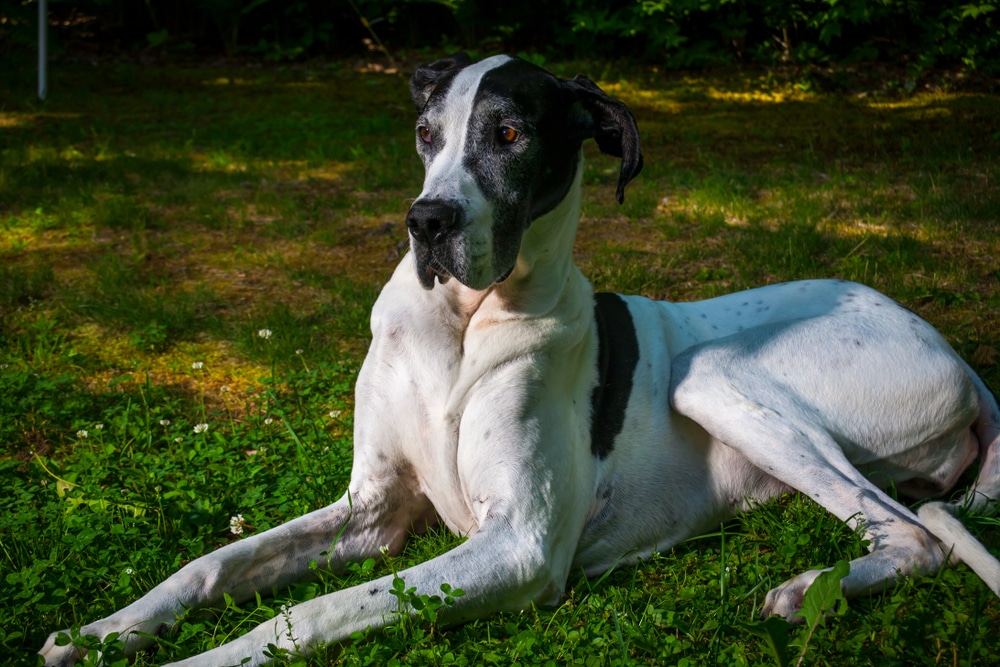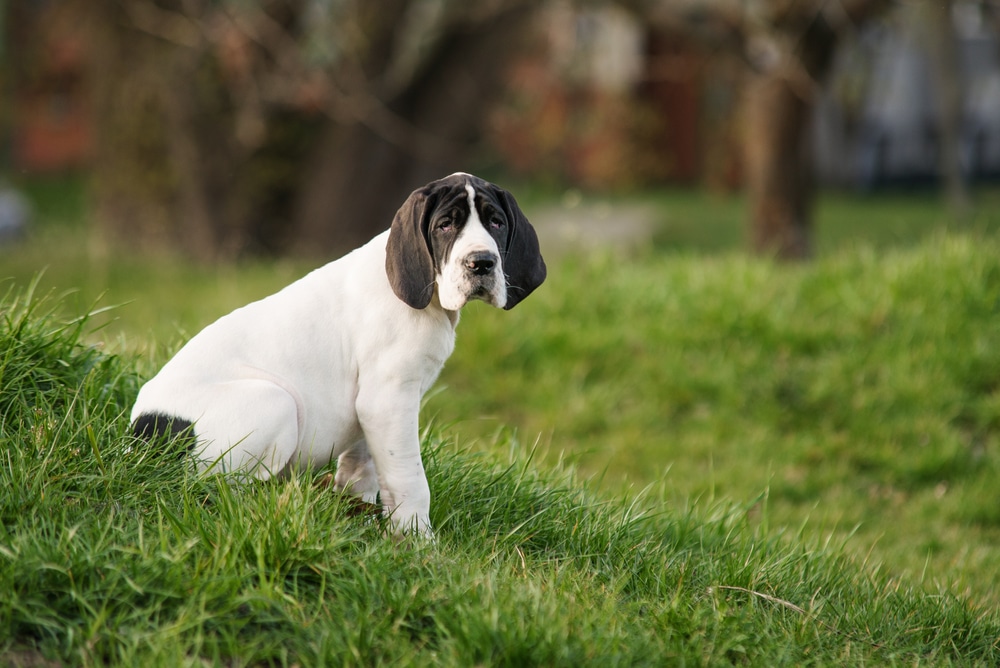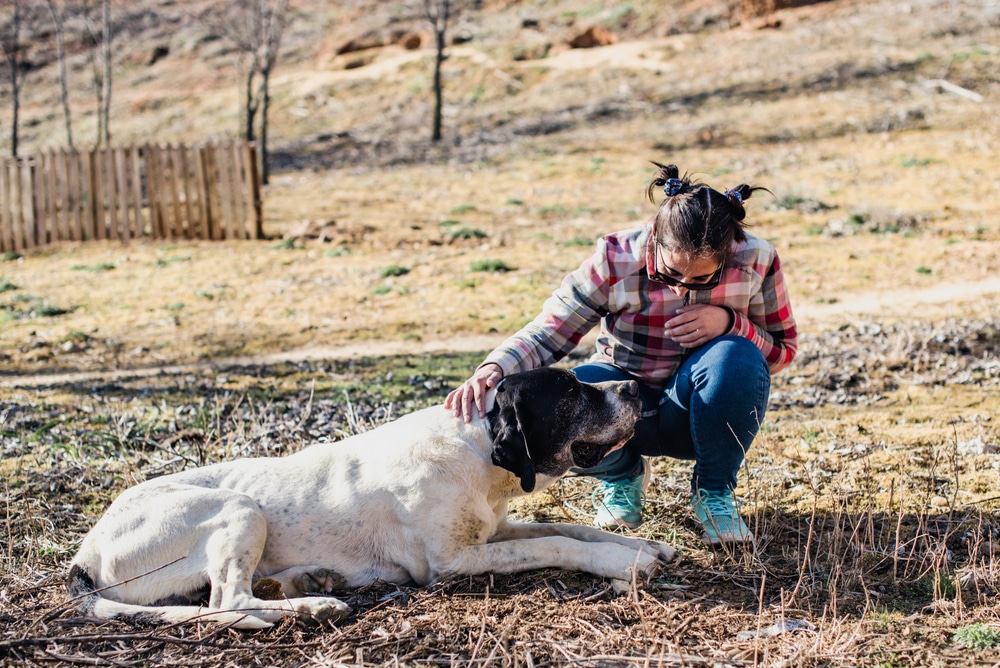“This post contains affiliate links, and I will be compensated if you make a purchase after clicking on my links.”
Last Updated on September 22, 2022
A Piebald Great Dane is the result of breeding Mantle and/or Harlequin Great Danes. It is one of the Great Dane’s many coat colors, but is not recognized officially by the American Kennel Club (AKC). Hence, Piebalds are considered a mismark of the breed.
So, what exactly is a Piebald Great Dane? Continue reading below to find out!
What is a Piebald Great Dane?
Piebald Great Danes are also called pinto, parti-colored, and colored-headed whites. They are confused with other coat color types such as the Mantles or the Harlequins, which is fair enough since most Harlequin and Mantle breeding produce Piebalds.
The main difference between other coat colors and the Piebald Great Dane is that the Piebald gene results in a predominantly white coat. Probably the best comparison to their coat color is that of a cow’s black and white markings.
Appearance

A Piebald Great Dane’s coat is caused by a gene that creates a predominantly white base coat with small, irregular splotches of color (usually, black) on a dog’s body. Usually, their head is that of a Mantle, in which it is mostly black.
Piebalds are dogs that have at least half of their coat in white. The percentage of the white color on their coat could be more as well. Generally, 80%-90% white coloration is common in Piebald Great Danes.
Furthermore, the color of a Piebald Great Dane’s head and tail are the last body parts to be affected by discoloration, and they mostly retain the usual black color in those areas.
These are some of the coat traits of a Piebald Great Dane:
- Dark eyes and a white muzzle
- One black side and one white side bearing black spots on its body
- Three big black splotches on one side of the body
- Whole white with black coat around the tail or a colored tail
A Piebald Great Dane will initially display black spots that may develop as irregular splotches on their white coat as they grow up. This spotting phenomenon is very common in dogs. In other dog breeds, this is called ticking, but in Great Danes, it’s called freckling.
How to differentiate a Piebald from a Harlequin
Piebald Great Danes are commonly mistaken as mismarked Harlequin Great Danes. As a phenotype, the Piebald is a common coat pattern seen in many animals, and not just in dogs. But in canines, their difference with the rare Harlequin coat is that Piebalds have fewer splotches.
Below, you’ll see the main difference between a Piebald Great Dane and a Harlequin.
| Piebald Great Dane | Harlequin Great Dane |
| One to three round smooth-edged splotches | Numerous irregular-shaped patches |
| Full black head and white muzzle | Visible leg markings |
| Dark eyes | A visible Merle “spot” which is grey or brownish |
Piebald Coat Color Variations

While the Piebald Great Dane’s coat color is usually white and black, there is a variety of other coat colors for this Great Dane, too. But some of the most common variations are:
1. Fawn Piebald Great Dane
Such dogs are genetically Fawn Great Danes. They have a white base coat and fawn splotches across their bodies.
2. Harlequin Piebald Great Dane
A Piebald Harlequin Great Dane is often called a Harlequin head white. These Great Danes are born when the Piebald gene fuses with the Harlequin gene. A Harlequin Piebald has a few body spots and is genetically regarded as a normal Harlequin.
3. Merle Piebald Great Dane
Merle Piebald Great Danes are called Merle heads by Great Dane breeders. The Piebald gene together with the Merle gene can produce this coat color. The dogs look similar to Merlequin Great Danes. And they have a white base coat and Merle-colored splotches on their bodies. For this reason, they are often inaccurately registered as Merlequins.
4. Boston Head Piebald Great Dane
A Piebald Great Dane holding a uniform genotype and phenotype is called a Boston Head Piebald. These dogs are considered straight Piebalds due to their singular physical and genetic appearance. The dogs’ head appear closer to a Mantle but the body has black splotches instead of a black blanket.
Genetics
Piebald Danes are somewhat more than a mere mismark. For example, mismarked Mantle Danes are genetically Mantles, just with not enough white coat to fall under the accepted range of show Mantle markings. However, this is not the case for Piebalds. While they do come from breeding Mantles or Harlequins, their genetic make up is different.
The Piebald Gene
There is a major lack of certainty about Piebald Great Danes. People get confused due to the differences in breeds specifications and appearance. And because of this, it is quite difficult to recognize a Piebald Dane.
Genetically, a Piebald Dane possesses a pair of white spotting genes(S\S). Regardless of the coat color, the Piebald gene can influence any Great Dane’s coat color. Hence the dogs can occur in numerous Great Dane colors. Furthermore, the Piebald gene is considered an “excessive white gene”. Hence, making the Piebald Great Dane’s coat patterns inconsistent unlike other coat colors.
The most recognized Piebald Great Dane is a Great Dane that is a result of Mantle breeding. They have a black head (like a Mantle) but since they have a Piebald genetic make up, their white coat is predominant and they have irregular splotches.
And these dogs are also called “Plattenhund”, especially in some European countries, and are alluded to as “color-headed whites”.
Health

There are health problems associated with the Piebald due to loss of pigment. The white coat color of a Piebald Great Dane is not only decorative, but is structural. Meaning the more white coat they have, the less pigment they have. And this is why Piebalds are considered genetically flawed.
And Piebald, in its extreme form, meaning when there’s too much lack of pigment, is associated with health problems such as deafness.
Furthermore, given their huge white bodies, Piebald Great Danes may be prone to sunburns and other skin problems like double Merle Great Danes because of the lack of melanin.
Typically, there are some hearing defects that are linked to the Piebald. However, there is a comparatively less percentage of reported hearing impaired Piebald Great Danes than double Merle Great Danes.
Breeding
A Piebald Great Dane, as mentioned, is a result of breeding two Mantle or Harlequin Great Danes. When a litter has even one Piebald Great Dane puppy, it means the parents carry a Piebald gene.
However, intentional breeding of two Piebalds is frowned upon. Given the high probability of producing white and deaf dogs in the litter, responsible breeders do not mate mismarked Danes like the Piebalds together. Having these dogs in a pedigree will make the coat color of the litter diminish later on.
Other potential litters from intentional Piebald breeding are Mantle Great Danes. However, since such Danes hold blankets with irregular blotches, they are not favored for Great Dane dog shows and are referred to as mismarks.
However, even though breeding Piebalds is frowned upon, Piebalds are not rare and are much more common than other mismarks such as Fawnequins. Furthermore, like any Great Dane, Piebalds make great pets and family companions.
Anti Piebald Breeding
As mentioned above, breeding two Piebald Great Danes intentionally is frowned upon. While litters from breeding two Piebalds appear fine and capable, all the puppies in that litter are genotypically and/or phenotypically Piebalds.
For example, if an accurately marked Harlequin Great Dane is bred with a Piebald Great Dane (carrying two Piebald genes), the litter may include two perfectly-marked Mantles, two perfectly-marked Harlequins, 2 Boston Headed Merles, and two Piebald puppies.
Now, while this litter produced perfectly-marked Mantles and Harlequins, they still carry one of their parents’ Piebald gene. When these perfectly-marked Danes are used as breeding stock, they will produce more and more Piebalds in the future.
Having more Piebalds in the litter mean more chances of producing unhealthy Great Danes. And in the long run, this might alter the breed standards for the Great Danes.
Responsible and moral breeders strive to keep their breeding stock healthy and defects free. So, to identify or detect Piebald genes in a Great Dane, the dogs undergo gene tests to prevent having Piebald Great Dane puppies in any litter.
Tips for Buying a Piebald Great Dane

While Piebald Great Danes aren’t qualified as show dogs, they are 100% amazing pets, considering that they share the same characteristics and temperament as other Great Dane colors.
If you are looking to buy or adopt a Piebald Great Dane, here are some tips for you:
- Purchase the puppy from a responsible breeder only. This would indicate that the Piebald is not the result of intentional breeding. Given that a reputable breeder will refrain from using mismarked dogs in breeding.
- Ask the breeder if they have performed Orthopedic Foundation for Animals (OFA) tests on parents involved.
- Request a hearing test for the puppy. This is because Piebalds can possibly have hearing problems due to their genetic make up.
- Ask if the dog is spayed or neutered (only if you’re adopting a Dane old enough to be spayed/neutered.)
- Remember that a mismarked Dane including Piebald should be sold on limited registration. Hence, the breeder must sell Piebald puppies on AKC‘s limited registration.
Our Recommendations
Piebald Great Danes might not be fit for breeding and dog shows, but they still make a great addition to your family because they’re friendly, loving, social and loyal dogs.
However, you have to remember that a Piebald Great Dane is predisposed to certain health conditions due to its coat color. So, make sure to do your homework to ensure your Piebald gets to live a healthy life. And of course, buy from responsible and reputable breeders only or adopt one from a rescue shelter.
Do blue eyed Pie bald danes have vision problems?